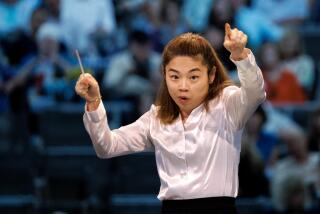Music review: L.A. Philharmonic is at home in Lutoslawski’s world
Every sound in Witold Lutoslawski’s exquisitely made music seems there for a purpose, although what that purpose is can be hard to say. One thing in the Polish composer’s scores generally leads to another, but why can be another conundrum. The music represents a world meant, for whatever reason, to be as it is.
The Los Angeles Philharmonic New Music Group’s glorious Green Umbrella concert Tuesday night in Walt Disney Concert Hall was Lutoslawski themed. The two Lutoslawski pieces played included the luminous late song cycle “Chantefleurs et Chantefables,” which the L.A. Phil was first to record in 1994, the year the composer died and four years after it was written.
There were also works by the orchestra’s conductor laureate Esa-Pekka Salonen and its former consulting composer Steven Stucky, both of whom were close to and influenced by Lutoslawski. The evening’s conductor was the L.A. Phil’s resident conductor Lionel Bringuier, who was mentored by Salonen and who has just been appointed the next music director of the Zurich Tonhalle Orchestra. It was a family affair, Lutoslawski passed from generation to generation, revealing just how much the composer meant to this orchestra. But, as ever, the mystery behind the music remained.
PHOTOS: Arts and culture in pictures by The Times
The program began with Lutoslawski’s Partita for violin and piano. In his comments on the score, which was written in 1984, the composer notes that he plays around with refined 18th century rhythms. But the expression might be called somberly sensational. Concertmaster Martin Chalifour and pianist Joanne Pearce Martin exploded virtuosic fireworks with a sparkling elegance that is a Lutoslawski hallmark. But they were equally willing to leave us with the melancholy smoke and dying embers that make the more lasting impression.
Bringuier then conducted Stucky’s “Ad Parnassum,” a mixed sextet with a heavy dose of percussion. Stucky too makes historical allusions to the 18th century — a musical treatise called “Gradus ad Parnassum” — as well as to a 1932 painting by Klee. Also like Lutoslawski, he reminds of a today tied to a yesterday.
A video clip was shown at the preconcert talk of Lutoslawski sitting by a Studio City backyard swimming pool in 1985, incongruously dressed in a coat and tie. The dappling light of Stucky’s music, however, suggests something else, a welcoming dip in the water. Bringuier’s performance dazzled.
After intermission, four L.A. Phil string players tackled Salonen’s “Homunculus,” a short string quartet from 2007. The title is quirky, referring to the arcane theory that once proposed the phallus as a “little man.” The composer impregnates his quartet with elements that give birth to various musical themes but leave their growth to the listener’s imagination.
This too is vaguely Lutoslawski-like. Salonen’s swirling sound world moves Debussy and Ravel into the 21st century. Melodic action is born from a kind sonic amniotic fluid, never fully formed but seeming ready for action.
Written for a not terribly well-known ensemble, the Johannes Quartet, the 15-minute piece has been neglected; it hasn’t been recorded. The L.A. Phil players (violinists Nathan Cole and Akiko Tarumoto, violist Benjamin Ullery and cellist Jonathan Karoly) brought out the lush beauty of the string writing so thoroughly that maybe they should head for the recording studio.
The concert ended with “Chantefleurs et Chantefables” (Song Flowers and Song Fables), Lutoslawski’s setting of nine short songs French Surrealist poet Robert Desnos wrote in a Nazi concentration camp shortly before his death. Salonen’s L.A. Phil recording with soprano Dawn Upshaw set a high bar for songs in which Lutoslawski found a direct means for making slightly absurd images haunt a listener’s imagination long after the music stops.
Bringuier and his soloist, Laura Claycomb, were more emphatic and a little less cagey than Salonen and Upshaw of 18 years ago. But they missed nothing, beginning with a beautiful rendering of the cycle’s evocation of moonlight and sleep. Desnos lives here wistfully through observing the life around him, be it a rose, grasshopper, tortoise or a vexed alligator. Lutoslawski becomes almost cute in some of his sound effects. But that only makes his cold eye sharper in every musical denouement.
And in yet one more instance of one thing leading to another, Salonen returns to lead the L.A. Phil this weekend, when there will be another recent piece of his and another Lutoslawski-Desnos song cycle.
MORE
INTERACTIVE: Christopher Hawthorne’s On the Boulevards
TIMELINE: John Cage’s Los Angeles
PHOTOS: Arts and culture in pictures
More to Read
The biggest entertainment stories
Get our big stories about Hollywood, film, television, music, arts, culture and more right in your inbox as soon as they publish.
You may occasionally receive promotional content from the Los Angeles Times.











